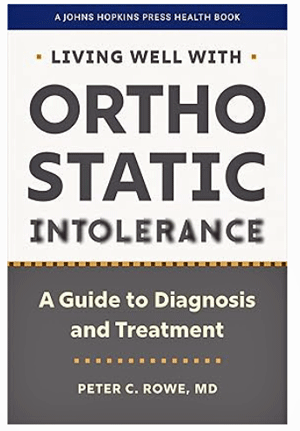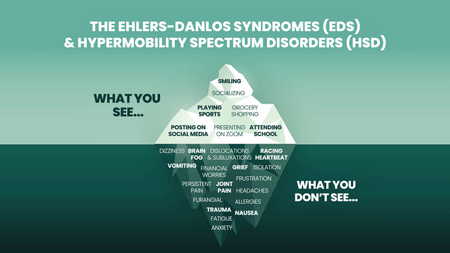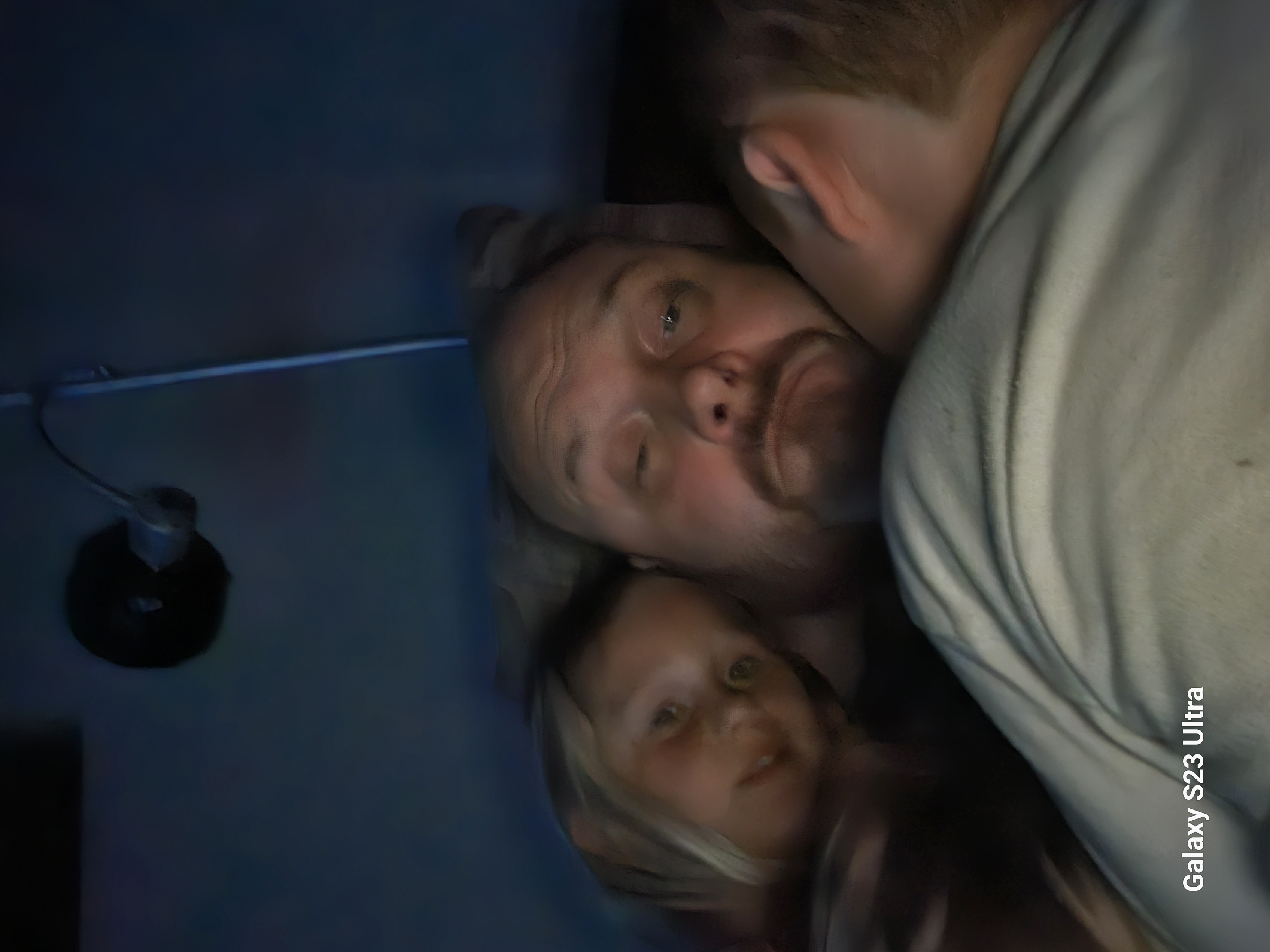

Geoff’s Narrations
The GIST
The Blog

Peter Rowe M.D. has been piling up firsts in ME/CFS for decades. He is the field’s foremost authority on orthostatic intolerance – and now he’s published a book.
This blog contains a review of Dr. Peter Rowe’s new book, “Living Well with Orthostatic Intolerance: A Guide to Diagnosis and Treatment“, and a talk with Dr. Rowe. Dr. Rowe is the first person to publish a book on diagnosing and treating orthostatic intolerance (OI); i.e. the inability to stand, or sometimes even be upright, without symptoms.
That’s no surprise! Dr. Rowe broke the news on OI and ME/CFS decades ago and has been piling up firsts ever since. It’s hard to imagine what the chronic fatigue syndrome (ME/CFS) field would be like without him. He was the first to:
- find neurally mediated hypotension in ME/CFS in 1995
- find neurally mediated hypotension in FM in 1997
- produce an OI clinical trial in ME/CFS in 2001
- find neuromuscular strain in ME/CFS in 2013
- document the effects of dairy in ME/CFS patients with intolerance to cow milk protein in 2016
- show that short-duration tilt table tests missed many people with POTS (and should be abandoned) in 2018
- show that health-related quality of life was substantially worse in children with ME/CFS than in a variety of serious diseases in 2019
- show that virtually everyone with ME/CFS, whether or not they met the criteria for OI, has reduced blood flows to the brain in 2020
- even sitting up dramatically reduces blood flows to the brain in people with more severe ME/CFS in 2020
- show that deconditioning does not cause OI in ME/CFS in 2021
- show that brain blood flows are reduced in long COVID in 2021
- show that cervical stenosis can mimic the symptoms of ME/CFS in 20213
- that chronotropic incompetence was occurring during tilt table tests in ME/CFS in 2023
- show that even elite swimmers can suffer from OI – and benefit from treatments to address it in 2023
- connect dysautonomia to post-treatment Lyme disease in 2024

“Living Well with Orthostatic Intolerance” should be on every person with ME/CFS, POTS, Long COVID, fibromyalgia, etc’s shelf
Rowe has also run the only pediatric clinic for ME/CFS (Chronic Fatigue Clinic at Johns Hopkins Children’s Center) that I know of, for decades.
THE GIST
- Peter Rowe MD, the founder and director of the Chronic Fatigue Clinic at Johns Hopkins Children’s Center has produced a rather staggering number of firsts (first to document OI in ME/CFS, first to run an OI trial in ME.CFS, etc.). Now he’s published the first book on orthostatic intolerance “Living Well with Orthostatic Intolerance: A Guide to Diagnosis and Treatment” for people with these diseases.
- The book was primarily written for patients and their families – but I think the place I would want to see it most would be sitting on a doctor’s shelf (or on her/his Kindle :)). Besides abundant information on Dr. Rowe’s medication dosing, the book shows how he works with a patient, tweaking this and that medication until the patient either hopefully gets significantly better or even recovers.
- While dramatic recovery stories are found in the book, this isn’t a “do this and cure OI” book. While Rowe is often able to help, he is clear that he hits a wall with some patients. These are not diseases that succumb to a kind of cookie-cutter approach. Each patient is an individual and it can take time and patience to track down the combination of treatments that work best for her/him.
- One of the book’s great contributions is to empower physicians and patients not to give up too early in their journey and to recognize that they could be a step or two from a life-changing treatment. Similarly, the book empowers patients to look for the kind of healthcare provider who is willing to experiment. If they can find that practitioner, they have a real shot at better health.
- The diagnosis section outlines a standing test that patients can take at home and bring the results to their doctor. If the test is positive, patients can take the results, plus perhaps the paper that validates the test, and/or blogs from Health Rising, to help educate their doctors.
- Rowe describes the symptoms associated with these types and subtypes, the large array of non-pharmacological approaches (from cooler showers/baths to small, low-carb meals, to using shoes with a higher heel, to elevating the head of the bed, compression, and cooling garments, increasing salt intake) that can help.
- One of Rowe’s more intriguing discoveries concerns the “movement restrictions”, “increased mechanical tension” and “postural asymmetries” he finds in many of his patients that can set off the symptoms of OI. Relieving these via gentle manual physical therapy techniques such as neural mobilization, myofascial release, strain-counter strain maneuvers, and craniosacral therapy often helps patients tolerate aerobic activity better.
- Rowe describes the many conditions – some of them quite obscure – that can be associated with OI. treatment algorithms he’s developed over decades of practice, talks about diet and provides an in-depth look at drugs he commonly uses. For me, I learned that stimulants, antidepressants, and birth control pills can all play a role in some patients’ treatment regimens.
- The most fascinating part of the book, though, were the 10 case histories detailing the different kinds of OI that Rowe sees and the many treatment approaches he employs. What worked for “The Dancer” (see blog), was different from what worked for the “Teenager with the Purple Feet”, “The Spinal Patient”, or “The Complex Case”.
- After the book review comes a talk with Dr. Rowe during which he talks about how the book came about, the role blood vessel problems may play in all sorts of diseases, why it’s important to improve circulation before trying to exercise, a patient he hasn’t been able to help, a new kind of spinal problem that can cause OI, and much more.
Living Well with Orthostatic Intolerance is a brilliant and timely book that will help patients around the world. Written by an international expert with decades of experience, Dr. Rowe provides the basics, the latest treatment approaches, and invaluable clinical pearls and patient vignettes. This book brings light into the darkness of this much misunderstood disorder.
―Brian A. Fallon, Columbia University Irving Medical Center
Dr. Peter Rowe has compiled his decades of clinical experience in caring for people with chronic fatigue and POTS into a highly readable and informative volume. This book is essential reading for those living with orthostatic intolerance, and for those who care for them. The tools for a deep understanding of this challenging clinical problem are all here.
―Clair A. Francomano, Indiana University School of Medicine, Co-Editor, Symptomatic: The Symptom-based Handbook for Ehlers-Danlos Syndromes and Hypermobility Spectrum Disorders
Rowe has produced superb treatment summaries for OI in the past – but this is not them. This is a full-fledged examination of OI, complete with all sorts of interesting asides and tweaks and case reports that you won’t get anywhere else. (The book grew out of a workbook that Rowe had been adding onto for decades. All proceeds from the book go to supporting his clinic.)
It’s not a dense tome – it was primarily written for patients and their families – but I think the place I would want to see it most would be sitting on a doctor’s shelf (or in her/his Kindle :)). Besides abundant information on Dr. Rowe’s medication dosing, the book shows how he works with a patient, tweaking this and that medication until the patient either hopefully gets significantly better or even recovers.
While dramatic recovery stories are scattered throughout the book, this isn’t a “do this and cure OI” book. While Rowe is often able to help, he is clear that he hits a wall with some patients. These are not diseases that succumb to a kind of cookie-cutter approach. Each patient is an individual and it can take time and patience to track down the combination of treatments that work best for her/him. In our talk, Rowe said:
“There’s a tremendous amount of inter-individual variability in the responses to medications and the number of things that people are dealing with. So it’s it’s really a puzzle to be sorted out for each person, and there’s no one size that fits all.”
This, of course, is why specialists like Rowe are so valuable. One of the book’s great contributions is to empower physicians and patients not to give up too early in their journey and to recognize that they could be a step or two from a life-changing treatment. Similarly, the book empowers patients to look for the kind of healthcare provider who is willing to experiment. If they can find that practitioner, they have a real shot at better health. (Note – Health Rising’s Doctor Review project will be up soon.)
It all starts with diagnosis, and with many doctors ignorant about dysautonomia or orthostatic intolerance, getting properly diagnosed can take some work. It took years before Lauren Stiles rather dramatically self-diagnosed her own case of POTS while in the hospital. Similarly, in his recent book, Matthew Robinson reports that he saw dozens of doctors before he was diagnosed with POTS at the Bateman Horne Center. The diagnosis helped both turn their health around.
The diagnosis section outlines a standing test that patients can take at home and bring the results to their doctor. If the test is positive, patients can take the results, plus perhaps the paper that validates the test, and/or blogs from Health Rising, to help educate their doctors.
(Doctors can follow up with tilt table tests if they wish, but the Doppler ultrasound test presents an intriguing possibility for enterprising doctors as the equipment is widely used and only requires the proper software. (Dysautonomia International has been providing the equipment to some doctors.) The dramatic drops in blood flows to the brain typically seen will surely spark the interest in even a skeptical doctor.)
Rowe describes the symptoms associated with these types and subtypes, the large array of non-pharmacological approaches (from cooler showers/baths to small, low-carb meals, to using shoes with a higher heel, to elevating the head of the bed, compression, and cooling garments, increasing salt intake) that can help.
One of Rowe’s more intriguing discoveries concerns the “movement restrictions”, “increased mechanical tension” and “postural asymmetries” he finds in many of his patients that can set off the symptoms of OI. Relieving these via gentle manual physical therapy techniques such as neural mobilization, myofascial release, strain-counter strain maneuvers, and craniosacral therapy often helps patients tolerate aerobic activity better.
Rowe describes the many conditions – some of them quite obscure – that can be associated with OI including median arcuate ligament syndrome, thoracic outlet syndrome, cervical spinal stenosis, Chiari type I, craniocervical instability, pelvic vein incompetence, endometriosis, irritable bowel syndrome, mast cell activation syndrome).
He provides treatment algorithms he’s developed over decades of practice; i.e. high systolic BP calls for these drugs; high heart rate at baseline suggests the doctor try these drugs first; etc.
Rowe raised my eyebrows when he noted that stimulants don’t just stimulate the nervous system but also can help the blood vessels in the legs vasoconstrict or narrow, thus driving more blood to the brain. He raised my eyebrows even more when he reported that antidepressants (SSRIs; Prozac, Zoloft, Lexapro, SNRIs: Effexor, Cymbalta) can increase circulatory functioning in people with OI. (Who knew?) Birth control pills are another potential mediator of OI symptoms that I had not heard of.
Deep dives into how to use common medications such as florinef, atenolol, stimulants, midodrine, SSRIs, Mestinon, desmopressin, clonidine, guanfacine, and ivabradine give an interested doctor a good head start on how to pharmacologically treat OI.
Case Histories
My favorite section of the book, though, contains 10 case histories demonstrating the wide range of orthostatic problems that can be present, and the even wider range of treatment options available. Here are some of them:
The Former Dancer

Joint hypermobility was present in several of the case reports
There was the former dancer (possible hypermobility clue), with purple hands and feet, occasional periods when her vision goes black, and who experienced lightheadedness and headaches and had trouble standing long enough to do her physician rotations.
Upon examination, she had a high Beighton score (hypermobility) and a 10-minute standing test suggested she had POTS. An increase in breathing rate at the end of the standing test suggested that she was losing CO2 – causing the blood vessels in her brain to vasoconstrict (narrow) – resulting in cognitive problems.
Over a period of six months or so, Rowe and the patients settled in on a course of atenolol, oral contraceptive pills, and midodrine (to counteract connective tissue laxity in her blood vessel walls). Ten years later, she had dropped the stimulant and was only taking atenolol, and her POTS symptoms were greatly reduced.
The Teenager with the Purple Feet
A 16-year-old female was healthy and active until she began experiencing fatigue, unrefreshing sleep, dizziness, headaches, post-exertional malaise, difficulty concentrating, and was unable to attend school.
On exam, she displayed acrocyanosis (purplish feet), a high Beighton score (hypermobility), high heart rate and low blood pressure during a tilt table test. She was diagnosed with POTS and neurally mediated hypotension.
Fludrocortisone (Florinef) and increased salt and fluid intake allowed her to resume school, begin working at two jobs, and exercise again. Ten years later, she was doing fine – except for periods when she had to temporarily discontinue Florinef.
The Spinal Patient
She had been well until the age of 12 when she was hit with a gastrointestinal infection that destabilized more than her gut. By the time she was 15, her fatigue, lightheadedness, and brain fog left her unable to attend school.
While her tilt table test indicated she had POTS, medications failed to help. An alert physical therapist who found increased tension in neck muscles dug further and found that she exhibited a positive Hoffman’s sign – which is often found in those with abnormalities in their cervical (neck) spine.
Interestingly, her mother had quite a history of neck problems: cervical spinal stenosis (narrowing of the spinal canal through which the cerebral spinal fluid flows), two spinal fusions, and two operations for thoracic outlet syndrome.
An MRI showed an abnormal clivo-axial angle (CXA), a narrowed cervical spinal canal (spinal stenosis), and a congenital disc bulge at C6-C7. (The clivo-axial angle is the angle between the base of the skull and the axis of the spine. Her reduced CXA suggested that her skull was compressing the brainstem; i.e. that she had craniocervical instabililty.)
Two months after undergoing the least invasive surgery possible (disc replacement at the C6-C7 bulge), she was able to work as a dog walker and vet tech, and experienced significant reductions in her anxiety and lightheadedness.
Six months later, she was working at a dude ranch for the summer and a year later, she was a full-time college student holding down a part-time job. A standing test indicated her POTS had resolved.

After trying numerous other treatments, the key to this patient’s recovery was Ivabradine.
Finding the One Thing
A cytomegalovirus virus kicked things off in this 14-year old. She managed to make it through both high school and college but was unable to do much more than concentrate on her studies. Vigorous exercise kicked off her migraines.
Unlike the other patients, her orthostatic intolerance had been well diagnosed and she’d tried many treatments for it and her fatigue. Beta-blockers, fludrocortisone, propanolol, stimulants, Mestinon, clonidine, oral contraceptives and many others were tried to no avail.
Noticing that she had a high resting heart rate (>100 bpm), Dr. Rowe tried her on Ivabradine. It turned out that she had just missed the one drug that could help her. Ivabradine controlled her heart rate, allowing her to exercise. If she temporarily goes off the drug, her heart rate, lightheadedness, and cognitive and exercise problems return.
A Complex Patient

Several case histories featured people for whom getting off dairy products helped.
A 16-year-old male with a history of infectious episodes as well as colic as a child had been experiencing fatigue, lightheadedness, migraines, headaches upon standing, heartburn, abdominal pain, frequent awakening during sleep, mild depression, and mouth ulcers. His OI had been diagnosed, but fludrocortisone didn’t help. His high Beighton score (7/9), flat feet, and other symptoms indicated he was hypermobile.
His history of gastrointestinal symptoms and tenderness in the epigastric area (below the ribs in the upper abdomen) suggested he was reacting to something in his diet. Rowe diagnosed him with milk intolerance and turned to a compounded form of fludrocortisone that was free of dairy.
Rowe pointed out that that milk protein intolerance usually produces upper gastrointestinal symptoms, while lactose intolerance produces abdominal bloating, cramping, and diarrhea. He has found that if you are intolerant of dairy products and are taking them no treatments will help until the dairy is removed.
With his gut symptoms resolved, Rowe prescribed escitalopram, which improved his mood. To combat the migraines, lightheadedness that occurred up standing, and muscle tightness, Rowe added in 5-10 mg midodrine every 4 hours (3x daily) and he began working with a physical therapist. That resolved his migraines and allowed him to gradually expand his activity level.
A year later, he was able to more fully participate in soccer (without crashes) and join his tennis team.
Mestinon Scores in Complex Patient
An eighteen-year-old cross-country runner experiences unusual fatigue. Strep throat and a gut infection result in lightheadedness, fatigue and, particularly, gut pain and vomiting.
Tilt table testing indicates POTS. Midodrine (5 mg every 4 hours – 3x’s/day), fludrocortisone (0.15 mg 1x/day), amytriptyline (20 mg 1x/day), and compression stockings help with her gut pain and lightheadedness, and she’s able to start college. Another gut infection strikes, though, and her fatigue, etc., worsens, she’s having lots of gut pain and nausea most of the day, she’s feeling depressed, and her wellness score sinks to 35/100.
Dr. Rowe finds she has elevated left shoulder and rightward tilt of her neck, and physical therapy is begun.
After removing dairy from her diet, her gut symptoms and nausea disappear. A rejigger of her midodrine (10 mg/every 4 hours) and escitalopram (10 mg/day) ups her wellness score to 60/100 (!).
After laboratory testing suggested low iron (low hemoglobin (11.4), MCV-78, RDW – 14.9), supplemental iron improved her energy and allowed faster recovery from exercise.
After 6 weeks of part-time college classes, though, she had to withdraw because of excessive fatigue. Adding in pyridostigmine bromide (180 mg daily over time) did the trick: within a month, she was doing 45 minutes of kayaking.
By her 7th month followup, her wellness score was 75/100; at 8 months, it was up to 85/100 and she’d successfully returned to college. At 18 months, her score was up to 90/100; she made the Dean’s list at college and completed 2 5K races. She eventually completed a PhD in physical therapy and was able to wean off all her OI meds.
A Talk with Dr. Peter Rowe
I talked with Dr. Rowe about his new book, how he treats OI, and what he’s excited about right now in the field.
An Addendum to the Talk
Traditional 10-min Tilt Table tests – may catch most people with POTS but will “miss a lot of people who actually deserve to be treated” according to Dr. Rowe. They will miss people who would have experienced blood pressure drops if the test had been extended, as well as people who develop symptoms while being tilted upright after a time (presumably because of reduced blood flows to the brain) but don’t meet the criteria for OI. The key with tilt table tests is to focus on symptoms.
Lax Veins – Dr. Rowe recently showed that using stents to improve blood flows in the pelvis improved many of the ME/CFS-like symptoms in women with chronic pelvic pain/interstitial cystitis. Overly lax veins, probably caused by connective tissue damage, appear to be allowing blood to pool in the pelvis, producing symptoms of orthostatic intolerance, pain during intercourse, and other symptoms in this group.
Blood pooling/problems with blood flows appear to be a common theme in many disorders associated with ME/CFS and could be occurring in varicose veins, the pelvic region (interstitial cystitis), the abdomen/legs (POTS), irritable bowel syndrome (IBS), fibromyalgia, and, of course, ME/CFS (reduced venous blood flows in the legs, reduced preload, reduced blood flows to the brain.) The idea is that interrupting the free flow of blood anywhere in the body can impair blood flows to the brain as well.
Klaus Wirth and Mathew Lohn have proposed that reduced blood flows may be at work in endometriosis, and dysmenorrhea (painful periods), and may be affecting the “vasa vasorum” or small blood vessels that feed the large blood vessels. They’ve proposed that both precapillary cardiovascular problems (low blood volume, low cardiac filling, vasoconstriction issues) and capillary disturbances (microclots, large monocytes, damaged red blood cells, sticky red blood cells) may be causing blood flow problems in ME/CFS and similar diseases.
Finally – A Real Team – Rowe’s Johns Hopkins Pediatric Clinic was held together by paper and string for decades. At first, he worked by himself. Next he got a research volunteer, then a nurse. Lately, he’s been able to hire two more people including a doctor focused on ME/CFS and long COVID. Finally, he said, he has a “real team”. The clinic has been helped greatly by philanthropic donations.







I’m so happy for Dr Rowe’s patients, and what an amazing Dr to get those results. And yet of course for so many of us, we’re medically abandoned, on the outside looking in, because we are unable to find or access a Dr who is willing to experiment like Dr Rowe does. For those of us able to self-advocate effectively though, both this article and the book it’s about could provide some useful direction.
This is such an apt point. As I was doing the blog I thought how good it would be to see someone like Dr. Rowe who is so immersed in orthostatic intolerance as well as neuromuscular tension.
I hope people can take this book and give it to their GP’s or nurse assistants or whomever they are seeing. Just doing the NASA lean test could really open things up for many I think.
I’m definitely going to buy a few copies. I know of several doctors and specialists who should learn about POTS/dysautonomia if they are open to learning that is.
Dr. Rowe has been one of the heros of the Ehlers-Danlos crowd. I have been following him for over 2 decades. I’m going to order his new book to replace all my saved research papers of his work.
It’s quite amazing just how much dysautonomia can throw off the entire bodily system. Thank you Cort, for featuring him and his new book!
Thanks, very useful summary! I’ll definitely be getting a copy of the book. The mention of more obscure postural and movement issues causing OI reminded me of Dr Michael Lovich’s practice in Functional Neurology. Perhaps you could consider him for a HR interview?
https://youtu.be/Ad4Y5BsKiGw?feature=shared
Thanks for the idea, John 🙂
I absolutely respect Dr Rowe for years. Indirectly through his research I was able to be diagnosed with a multitude of diagnoses related to ME/CFS.
I hate that he is retiring but he has truly helped our community.
Didn’t know he was retiring! He has been doing this for a long time, though. I imagine and hope he will keep busy with the research
Hi Cort, I saw an article about a fundraiser for Dr Rowe research and the caption under the photo stated that Dr Azola ( sees adults with ME/CFS and Long Covid) will be taking his place when he retires this coming year. That’s all I know.
Dr Rowe has helped me tremendously understand and treat my condition. Can’t wait to get his book and read about … flat feet!!! Maybe not everybody noticed it being mentioned by Cort but since I have flat feet… I am so very curious to know more about the connection with OI.
I know – flat feet! Who knew? I had no idea there was a connection between flat feet and hypermobility…
My OI was helped most dramatically by ten pass ozone . From being unable to sit for more than an hour with my feet up to being able to stand up / walk for an hour.
It’s not a cure because it needs continuous treatments, every 3 weeks or so and it’s expensive but I’ve found that peroxide baths every few days is a effective at maintaining my health and almost free.
I have to get the book, so many unanswered questions but Dr Rowe certainly hits the spot.
I was left wondering after an MRI on my brain some years ago, where it showed that the arteries on one side had narrowed. More investigation was suggested but I was adamant I didn’t want another MRI with dye injected into my body – I react to everything, so the talk about reduced blood flow to the brain is very interesting.
I cannot lie flat, or wear flat shoes, its all pointing one way, thank you Dr Rowe.
I am seriously thinking of leaving my brain to science for ME when I pass away.
This interruption in blood flow caused by narrowing or damage or microclots or red blood cell deformation – whether it occurs in blood vessels in the abdomen, pelvis, legs, neck or wherever seems to be a real thing…
https://www.healthrising.org/blog/2024/05/27/nih-chronic-fatigue-fibromyalgia-long-covid-brain-funding/
I have thought about that various times already. I hope I have still some time left, I am in my early 30s 🙂
But I feel like all the medical mistreatment I experienced and we as a patient collective historically experienced makes this a far more complex decision than it maybe would be with other diseases..
A Doppler ultrasound scan might be a gentler option. It’s non-invasive – no dye, just a bit of gel and possibly wearing a light headset if you have the transcranial scan. Unfortunately it is not widely offered, but you never know, there could be a centre offering it near you.
Perhaps this could be investigated with a Doppler ultrasound scan? It’s non-invasive, no dye needed.
Pectus Excavatum can be a major cause of OI, and it is treatable. Don’t be fooled by the “it’s-only-an-aesthetic-problem” argument. Don’t see a cardiologist; see a PE surgeon.
Interesting. I had never heard that. I have the opposite – pectus carinatum – another connective tissue issue I suppose.
I had a very severe PE with low lung volume and heart compression, as well as severe-to-very severe ME/CFS (plus EDS). I had surgery. My sternum was raised by about 10 cm, creating an extra 1 litre to 1.5 litres extra volume in my rib cage. Overnight my OI improved by 85%. All of a sudden I could stand up after spending 17 years in a bed. I became a moderate-to-severe ME/CFS case. My VO2max increased from 18 to 23 without doing anything special. Unfortunately, 6 years later, I had surgery on my shoulder, and physiotherapy to regain mobility of my arm has caused a severe deterioration, and my VO2max dropped to 13.
My experience taught me to try to fix anything that can be fixed. Often, an anomaly is noticed, but BECAUSE it cannot explain all symptoms, it is ignored and not treated. Doctors have that weird dogma that patients can only have one disease.
I am convinced that had I been treated for my PE when I was 15 instead of 45, I would never have been that ill or I would have started being very ill much later. I now have a thickening of the right ventricle that is not reversible and in fact progressive. Had I been treated early I would never have had that thickening.
Hi Isa
Thanks for sharing that. It’s another possibility for OI. Do you know how the pectus excavatum came about it? Is it genetic?
it seems it is an inherited disorder: https://pubmed.ncbi.nlm.nih.gov/17011272/
I also have pectus excavatum and OI (POTS). Mine isn’t very severe. I did consider having it corrected when I was younger, mainly due to issues with self-image. Now I wonder if that would have changed my symptoms over the years. I do not meet the criteria for EDS based on Beighton score (3/9), but I think I do have hypermobility spectrum disorder considering my joints, pectus excavatum, mitral valve prolapse, and POTS.
Dr. Peter Rowe is a treasure – I’m very sorry to hear he is retiring, but writing a book was an excellent idea!
I’ve bought a copy & hope he sells a ton of them to continue funding his clinic in perpetuity.
Since so many of us also have OI, I think it behooves us all to support him, if we can. He’s been a trailblazer.
They found infection in the brainstem in long covid
https://academic.oup.com/brain/advance-article/doi/10.1093/brain/awae215/7811070
A nice conversation. This doctor tries to identify and treat the symptoms of each patient. in a heterogeneous group. ! thing they have in common is othostatishce intolerance. I don’t think we can talk about ME here. By the way, milk is a culprit for many people with intestinal problems. What a complex story. It’s good that this doctor sees through it. There aren’t many of those. Thank you Cort for your nice conversation
Nice to see you in the interview, Cort.
Congratulations to Dr Rowe on his book.
I think it’s valuable to have a resource that looks at orthostatic intolerance generally, rather than just POTS.
It’s interesting to reflect on how one person, or a small team, can touch the lives of people worldwide by publishing good research. I have read Dr Rowe’s papers, especially his collaborations with the Stichting Cardio Zorg team, and personally benefitted from them.
My diagnosis eventually came via Dr Peter Novak’s work (he described my disorder in 2016) but stumbling onto Dr Rowe’s lectures and Cort’s articles here on orthostatic intolerance were instrumental early on.
Orthostatic intolerance should be in every doctor’s differential diagnosis toolkit when patients present with fatigue, presyncope, brain fog, exercise intolerance, nausea or cognitive difficulties.
Best wishes to Dr Rowe for his retirement.
Thank You so much Cort! So many groundbreaking findings and research from Dr Rowe.
I recently came across the lax (pelvic) vein’s connection to dysautonomia. I hope I can get in that checked out somehow. There also seems to be a lot of overlap between ME or Fibro and endometriosis. In Germany SFN is often listed as a co-morbidity of endometriosis, for whatever reason, I see it less in international research and clinical guidelines.
A lot of people are putting a lot of hope in Prof. Wirth’s work. Is his proposition regarding bloodflow in endometriosis and dysmenorrhea also part of his current hypothesis for the disease mechanism in ME/CFS (mitodicure)? That’s how I read it… but maybe that’s a different project and the mitodicure idea is, ME could function analogue to this?